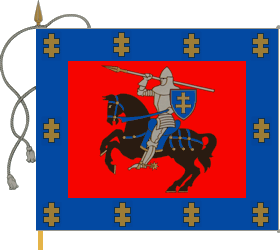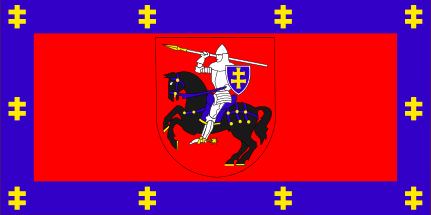
image by Virginijus Misiunas, 24 December 2009

Last modified: 2014-04-27 by zoltán horváth
Keywords: lithuania | vilnius |
Links: FOTW homepage |
search |
disclaimer and copyright |
write us |
mirrors

image by Virginijus Misiunas, 24 December 2009
See also:
Municipalities:
The source of the Previously Reported
Vilnius county flag is <www1.std.lt>
and personal observation at flag show in jubilee of
Mindaugas coronation 750th anniversary. The Arms of Vilnius
County was drawn according to my personal observation and photo,
which was taken from the catalogue of exposition in the
Parliament of the Republic of Lithuania, 15-30 March, 2002. In
the flag, the mounted knight is inside of red shield
Audrius Slapsinskas, 24 June and 7 July 2003
The flag of Vilnius county - Vilnius apskritis. All county
flags and Coat of Arms adopted on 2004 by Heraldic Commission of
Lithuanian Department of Interior.
Jens Pattke, 26 February 2005
Vilnius county - on a red field a silver knight on a black
horse holds a silver lance with a golden head, on the knight's
left shoulder a blue shield with a golden patriarchal cross,
saddle and leather parts of the horse clothing are blue, metal
parts of the horse clothing, horseshoes and knight's spurs
are golden, bordure is blue with 10 Jogaila crosses. Flag
proportions 5:6, free edges bordered with narrow silver stripe,
finial is a golden lance head with silver bands. The charge
originates from the National Arms.
Initially, the arms of early Lithuania / Vilnius duchy were not
distinguished from the arms of Vilnius dukes, i.e. of the Grand
Dukes of Lithuania. In the late 14th century the land arms
started being distinguished from the ducal arms: the knight of
the Grand Duke held the sword, and the knight of the Vilnius
duchy held the lance. The evidence is known both from the seals
of late the 14th century and from the armories of early the 15th
century (colours of the actual arms are restored
from pictures in Western European armories). The blue shield
with a golden patriarchal cross (the Jogaila cross did not
appear yet) symbolized the dependence of Vilnius land to the
Algirdas/Jogaila branch of Gediminas dynasty. In 1413 the
Vilnius duchy became Vilnius province (vaivadija).
The use of a black horse is quite intriguing: the horse of the
National Arms is white, and this is the symbol of sovereignity.
The black horse is mentioned in the Jan Dlugosz's description of
banners of Lithuanian regiments, and participated in the 1410
battle at Zalgiris / Tannenberg. Ten regiments from Trakai land
had the banners with "Gediminas gate" badge, showing
their dependence to the Kestutis/Vytautas branch, and 30
regiments of other Lithuanian lands (i.e. of Algirdas/Jogaila
domain) had banners with knights mounted on horses of different
colors: white, black, sorrel or dapple-grey. Those banners were
called by the names of the different lands and local dukes. It is
guessed that the white horse of the Grand Duke was replaced with
the horse of a different colour for showing the dependence of
land.
The knight with a lance was used by Vilnius province for about
150 years. Since the mid 16th century the knight with a sword was
used again. This modification was officially recognized during
the administrative reform in 1564-1565, and fixed in the Statute
of Lithuania in 1566 and in 1588: it demanded using the National
Arms for seals and military banners of Vilnius province. In fact,
the arms of Vilnius province were the same as the National Arms.
This variant of arms was used till 1795, when Lithuania fell to
Russian Empire. In 1795 the Lithuania province (governorate) was
established, but soon renamed to Vilnius province. During the
first decades of Russian rule, only the seals were used: the
Russian eagle in the upper part, and the Lithuanian knight in the
lower part.
Since the late 1830s a few projects of new arms of
provinces were provided. They proposed in the upper part the
knight with a triple (early Orthodox) cross and in the lower part
the tower of Vilnius castle. However Emperor Nicholas I granted
to Vilnius province the modified historical arms on April 6,
1845: on a red field a galloping silver knight on green ground.
The cross on the knight's shield was not the Jogaila cross but
the red Orthodox cross.
In 1858 Bernhard Koehne proposed the improvement of Vilnius arms.
He proposed the new image of the knight in defence: that was
historically correct. Also the double (Jogaila) cross should be
returned. The arms should be decorated with a five-towers mural
crown and with two golden spikes of wheat, bent with a red
Alexander stripe. But the arms were not changed that time.
On July 5, 1878 the new design of arms was confirmed. It was
based on Koehne's project but the Orthodox cross has remained,
the crown was of Russian Empire, and the decoration was two
golden oak branches bent with a blue Andrew stripe. These arms
were used till 1915. During World War I the German eagle was used
on seals. In 1920-1939 the Polish eagle was used on seals. The
project of Vilnius province arms was prepared in 1928 but not
confirmed. Later the Soviet and Reich symbols were used on seals,
and in 1945-1990 the arms of the Lithuanian SSR were used on
seals.
The arms of Vilnius land is one of oldest territorial symbols in
Lithuania. It may originate from the times of Grand Duke Algirdas
(some historians state the first evidence of its usage in 1366)
and it is undoubtedly the heraldic figure since the late 14th
century. Its usage continued till World War I, and only the fall
of Vilnius land from hand to hand wiped out the historical
symbolism. The Heraldry commission of Lithuania decided to keep
the earliest version of the knight with a lance for Vilnius land.
It is attributed both to Vilnius district and Vilnius county.
The blue border with 10 Jogaila crosses is a common element for
all counties of Lithuania: the border means dependence, the
Jogaila cross means Lithuania, and 10 means the number of
counties. Colours golden on blue are traditional for Jogaila
cross in Lithuanian
Virginijus Misiunas, 24 December 2009

image by Audrius Slapsinskas, 7 July 2003
vl.gif)
image by Audrius Slapsinskas, 19 June 2003